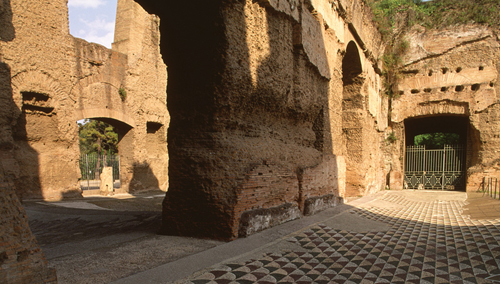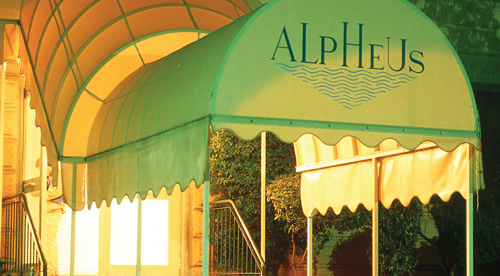Ancient Rome
This area has always been a contrasting mix of the highest and the lowest, from the most extravagant luxury to the toughest work-a-day world. In ancient times, the emperor’s lavish palaces were built on the Palatine, but they weren’t far from the docks, where roustabouts heaved the tons of goods that were imported to the wealthy city from around the world. There are three hills in the zone: the Palatine and the Aventine are two of the original seven, but Monte Testaccio is entirely man-made. Legend has it that the Aventine was where Remus formed a populist settlement, to rival his twin brother Romulus’s dictatorial encampment (see Romulus and Remus). Over the centuries it has been an area inhabited by poor workers and religious institutions. Today, it has returned to being an enclave of greenery and smart dwellings, studded with hidden art treasures and some of the world’s finest ancient monuments and priceless archaeological finds.
Class Divisions and Power StrugglesThe ceaseless struggle between the governing and the working classes is typified by the history of this area. Romulus on the Palatine versus Remus on the Aventine gave rise to patricians and plebeians respectively. The contrast still exists, between wealthy Aventine and down-to-earth Testaccio. |

|
|
NOTE
Roman Forum and Palatine Hill
Once the heart of the Roman empire, this mass of ruins is an eerie landscape that seems gripped by the ghosts of an ancient civilization (see Roman Forum).

Colosseum and Imperial Fora
These monuments memorialize Imperial supremacy. The Forum of Trajan was declared a Wonder of the World by contemporaries; the only remnant is Trajan’s Column, considered to represent Roman sculptural art at its peak. The Colosseum embodies the Romans’ passion for brutal entertainment (see The Colosseum and Imperial Fora).
Musei Capitolini
Notwithstanding their great beauty, the original motivation for these museums was purely political. When the popes started the first museum here in 1471, it laid claim to Rome’s hopes for civic autonomy – the Palazzo dei Conservatori was the seat of hated papal counsellors, who ran the city by “advising” the Senators. Today the museums are home to a spectacular collection of art (see Musei Capitolini).

Santa Sabina
This church was built over the Temple of Juno Regina in about 425 to honour a martyred Roman matron. In 1936–8 it was restored almost to its original condition, while retaining 9th-century additions such as the Cosmatesque work and the bell tower. Twenty-four perfectly matched Corinthian columns are surmounted by arcades with marble friezes and light filters through the selenite window panes. The doors are 5th-century carved cypress, with 18 panels of biblical scenes, including the earliest known Crucifixion – strangely without any crosses.
Piazza Pietro d’Illiria 1
Open 6:30am–1pm, 3:30–7pm daily
Free
DA
Santa Sabina
Baths of Caracalla
Inaugurated in 217 and used until 546, when invading Goths destroyed the aqueducts. Up to 2,000 people at a time could use these luxurious thermae. In general, Roman baths included social centres, art galleries, libraries, brothels and palestrae (exercise areas). Bathing involved taking a sweat bath, a steam bath, a cool-down, then a cold plunge. The Farnese family’s ancient sculpture collection was found here, including Hercules, a signed Greek original. Today, ruins of individual rooms can be seen.
Via delle Terme di Caracalla 52
Open 9am–2pm Mon, 9am–1 hr before sunset Tue–Sun
Adm
DA
Capital, Baths of Caracalla
Gymnasia, Baths of Caracalla
Piazza of the Knights of Malta
Everyone comes here for the famous bronze keyhole view of St Peter’s Basilica, ideally framed by an arbour of perfect trees (see Knights of Malta Keyhole). However, it’s also worth a look for the piazza’s wonderful 18th-century decoration by Giambattista Piranesi, otherwise renowned for his powerful engravings of fantasy-antiquity scenes. To honour the ancient order of crusading knights (founded in 1080), the architect chose to adorn the walls with dwarf obelisks and trophy armour, in the ancient style. Originally based on the island of Rhodes, then Malta, the knights are now centred in Rome.
San Saba
Originally a 7th-century oratory for Palestinian monks fleeing their homeland, the present church is a 10th-century renovation, with many additions. The portico of the beautiful 15th-century loggia houses a wealth of archaeological fragments. Greek style in floorplan, with three apses, the interior decoration is mostly Cosmatesque. The greatest oddity is a 13th-century fresco showing St Nicholas about to toss a bag of gold to three naked girls lying on a bed, thus saving them from prostitution.
Piazza Gian Lorenzo Bernini 20
Open 8am–noon, 4–7pm Mon–Sat, 9:30am–1pm, 4–7:30pm Sun
Free
Portico carving, San Saba
Pyramid of Caius Cestius
This 12 BC edifice remains a truly imposing monument to the wealthy Tribune of the People for whom it was built. It stands 36 m (118 ft) high and took 330 days to erect, according to an inscription carved into its stones. Unlike Egyptian originals, however, it was built of brick then covered with marble, which was the typically pragmatic, Roman way of doing things.
Piazzale Ostiense
Pyramid of Caius Cestius
San Teodoro
At the foot of the Palatine, this small, circular, 6th-century church is one of Rome’s hidden treasures. St Theodore was martyred on this spot, and his church was built into the ruins of a great horrea (grain warehouse) that stood here. The apse mosaic showing Christ seated upon an orb is original, but the Florentine cupola (1454) and other treatments are mostly 15th-century restorations ordered by Pope Nicholas V. The courtyard was designed by Carlo Fontana in 1705.
Via di San Teodoro
Protestant Cemetery
Also called the Acattolica (Non-Catholic) Cemetery, people of many faiths have been sepulchred here since 1738. The most famous denizens are the English poets Keats and Shelley (see Writers in Rome). Until 1870, crosses and references to salvation were forbidden.
Via Caio Cestio 6
Open 9am–4:30pm Tue–Sat, 9am–1pm Sun
Donation
Keats’ tombstone
A Morning Parkland Stroll
The parkland on the other side of the Circus Maximus from the Palatine Hill conceals exquisite early churches and other gems. Start on the south side of the Circus Maximus, now a sunken patch of dust and weeds, but once a majestic racecourse until the popes plundered its stones to build their palaces. Head up the hill to the Rose Garden . In spring and summer few places in Rome radiate such beauty. Continue along the old wall and enter Parco Savello’s Orange Garden to take in the view from the parapet. Next door is Santa Sabina . Use a torch and binoculars to scrutinize carved wooden doors and the Crucifixion scene. Stop next at Piranesi’s Piazza of the Knights of Malta and peer through the celebrated keyhole.
Wind down Via di San Alessio until Viale Aventino and San Saba. Take time to appreciate the notorious St Nicholas fresco on the left wall. In the Parco della Resistenza dell’8 Settembre you can get a gelato in the park’s café and gaze at length on the 3rd-century Aurelian Wall .
Cross over to the lovely Protestant Cemetery, pay your respects at the graves of Shelley, Keats and friends, pause to reflect on the splendid Pyramid of Caius Cestius, and leave your donation in the box as you exit.
Volpetti is a fabulous choice for lunch with a made-to-order gourmet sandwich.
Rome’s Trendiest Nightlife

Nazca
This is the place where Rome’s bright young things sip a well-mixed cocktail or two before sampling the other delights of the Testaccio-Ostiense area. It has a good sound system and an equally trendy restaurant.
Via del Gazometro 40
Radio Londra
One of Rome’s perennial favourites for an energetic night out. This is a noisy, buzzing rock-and-roll venue with an air-force theme and occasional up-and-coming live bands. Food is also available.
Via di Monte Testaccio 65B
DA
Villaggio Globale
Occupying part of an old slaughterhouse, the “Global Village” offers great world music, plus ethnic snacks. Winter only.
Lungotevere Testaccio
Akab
Cinema, art exhibitions and varied music keep all ages partying here.
Via di Monte Testaccio 68
06 5725 0585
Closed Sun, Mon
Café de Oriente/Caruso
Occasional Brazilian bands rock the samba, while the rest of the time Latin-tinged disco gets you going.
Via di Monte Testaccio 36
DA
Joia
Joia comprises a restaurant, wine bar, piano lounge, disco and a terrace on the top floor.
Via Galvani 20
06 5740 8062
Closed Sun, Mon
Caffè Emporio
This pub projects a genuine English atmosphere with a zippy Italian twist. Guinness is on offer, along with snacks.
Piazza dell’Emporio 2
DA
Traditional Roman Restaurants

Checchino dal 1887
Among the great Roman restaurants (see Checchino dal 1887), the menu offers offal-based delicacies such as rigatoni alla pajata (pasta with calf intestine).
Via di Monte Testaccio 30
06 574 6318
Closed Sun–Mon
Checchino dal 1887
Agustarello
Roman-style, heavy-duty dishes are the standard here. Sample tripe, coda alla vaccinara (oxtail), lingua (tongue) and other peasant fare (see Roman Dishes).
Via G Branca 98
06 574 6585
Closed Sun
No credit cards
Da Remo
One of Rome’s quintessential pizzerias. Authentic, cheap and always packed.
Piazza S Maria Liberatrice 44
06 574 6270
Closed Sun
No credit cards
Felice
This simple trattoria is one of the best places in the city to try the traditional carciofi alla romana .
Via Mastro Giorgio 29
06 574 6800
Closed Sun
Il Ristoro dei Cocci
The speciality here is delicious pizza, and the focaccia bread is among Rome’s best.
Via di Monte Testaccio 34/B
06 572 88940
Closed Mon in winter
No credit cards
Di Pietro
Good traditional Roman fare is served at this neighbourhood favourite, close to the Caius Cestius Pyramid. Take-away (tavola calda) is available from the buffet.
Piazza di Porta San Paolo 6A
06 578 0252
Closed Tue
Acqua e Farina?
At “Water and Flour?” practically everything on the menu, from savouries to sweets, is pastry-based and made to an original recipe.
Piazza O Giustiniani 2
06 574 1382
Closed L
Il Seme e la Foglia
Great for large salads and inventive sandwiches, such as goats’ cheese, radicchio and olive spread.
Via Galvani 18
06 574 3008
No credit cards
Né Arte ne Parte
Run by two Italian TV actors, the menu features such Roman classics as carbonara and roast lamb.
Via Luca della Robbia 15–17
06 575 0279
Closed Tue L, Wed L, 3 wks July
|





